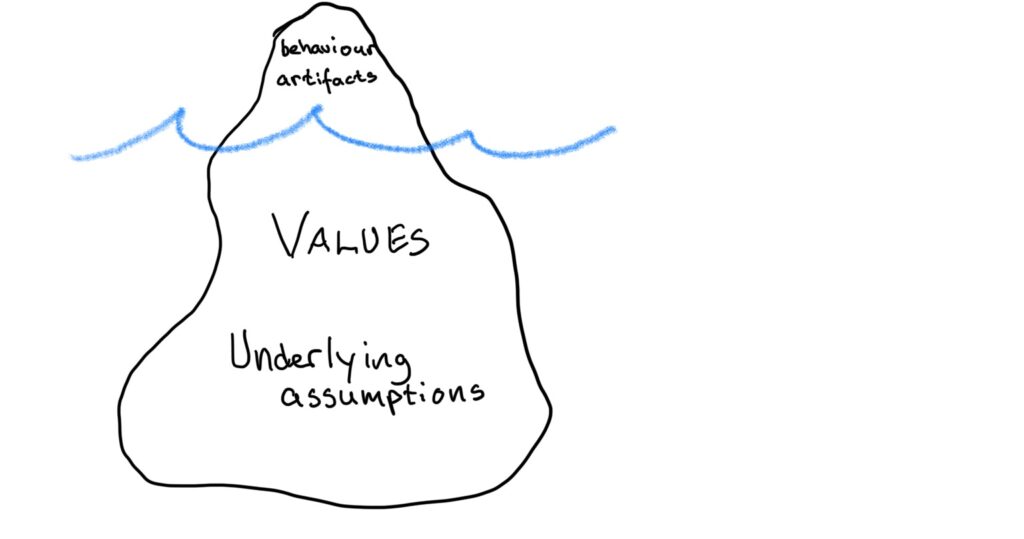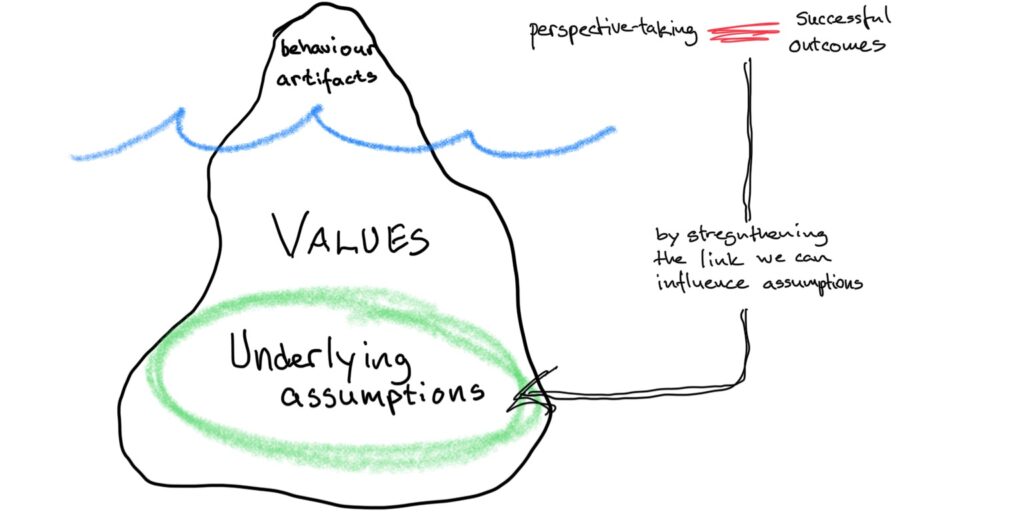If you want to infuse Perspective-taking, or any other skill, into your organisation’s culture then your job is to help people connect the practice of Perspective-taking to successful outcomes.

It is as simple as that. It will take time, and some work, but it is a straight forward process.
Since the release of the Harvard Business School case study “Leading cultural change @ SEB” I have gotten a few questions regarding my skills based framework to influence culture that is described in the case study. I also got a few questions on how an organization can infuse the Leadership backbone skills into their culture and reach the same effect that is described in the Harvard case. i.e. faster progress on strategic challenges, better decision making, gains in market share, ability to include new individuals/competences to mention some.
I believe that most culture initiatives fail because they focus on Values and are centered around Value workshops. This failure can be explained by Ed Schein’s, professor emeritus MIT, classic org culture model that shows us how a organization’s culture, and values, stem from the underlying assumptions employees have about what creates successful outcomes in their environment and in their organization.

If you believe in Schein’s model then Values will change if the underlying assumptions change, hence Values is clearly not the place to start if you want to influence the culture of a organisation. My approach has 100% focus on influencing people’s underlying assumptions and I do this by helping them train the skill (in this case perspective taking) and put it to use on their important business challenges (in the Harvard case the dialogues around complex strategic problems is highlighted).
When individuals realize that Perspective-taking can help them make progress on their most important complex challenges a link is formed.

Every time they reach successful outcomes by using the skill, or hear a story of others reaching success by using the skill, the link is fortified…

…and gradually the individual will start to assume that practicing the skill will creates success in her/his work environment.
If many people in an organization adopt the same assumption, for example: “Perspective Taking creates success when working on complex challenges”, and if the skill proves to create successful outcomes time and time again, then the assumption will be taken for granted as a fact and it will become what Edgar Schein, Professor emeritus @ MIT, calls a shared underlying assumption.

….and this is the foundation of an organisations culture according to Schein’s model. Once the assumption changes, what is valued (i.e. the real values that are often different then the values talked about in Value workshops) change, and so does behaviour. i.e. when a team encounters a complex challenge their natural behaviour will be to go into Perspective-taking mode because they assume that Perspective-taking is the best way to make progress on the complex challenge.
It takes some time to ingrain a new underlying assumption regarding a skill. Also, people need to learn, practice and get comfortable with the skill, but if you are pragmatic and focused this is an effective way to influence the culture of a team, or organization. The faster you can establish and reinforce the link….

…. the faster you can influence the culture, and improve performance.
In the Harvard case study Professor Amy Edmondson briefly describe my 5 steps to influence culture. I call this skills-based, or outcome-based, culture work, as opposed to the Value-based approach that most organizations use.
Step 1. Establish a shared language
To start people need to know what the skill is and how the skill can be useful to create success in their work environment. At this stage employees don’t have to practice, or even agree that the skill is important. However, they have to remember what the skill is, so it is good to use a name that sticks in peoples minds.
Step 2. Find a cultural champion
You need to connect the skill with success. Therefore one-off workshops and short interventions can do more harm then good as they often connect the skill to mediocre results or just a nice workshop (or worst, a waste of time)

Most organisations fall into this trap. By running many short interventions on for example Perspective-taking in an organisation you will create stories that link perspective-taking to mediocre outcomes.
It is a fact that most skills will build over time and regardless of the briliance of the team or the facilitator the really good outcomes will not occure the first time, or the second time you use a skill in a new setting.
Off course you should not shy away from making one-off interventions when needed, but if your goal is to influence the organisational culture you want to be mindful about the connections your initiatives are creating.
If your aim is to ingrain a skill in your culture it is absolutely crucial that you find someone that will [1] train the skill and [2] put the skills to use on important topics. This takes some time and commitment, but it is the only way to make the right connection.

Step 3. Ensure successful outcomes
To ensure successful outcomes, preferably bottom line results, new customer acquisition, solving a important strategic problem or similar, you want to give the participants a few chances to use the skills, so make sure your intervention stretches over time.
Also, you want to make the process iterative with several short interactions so that participants have time to improve through trial and error. Short, frequent interventions will also make sure that the new skills are top of mind for the participants. Further, a itterative process with several interaction points will allow the participants to experience (and hear about other’s experience) several examples of successful outcomes (at first on small stuff, in the end of the process on important strategic topics) through out the process.
Step 4. Share stories
Once you reach successful results share the stories through out the organization to [1] help employees across the organization see the link between the skill and successful outcomes, and [2] to recruit more people to go through a development process of their own. When more people go through training you will generate more successful outcomes, more stories and a stronger link.

Step 5. Scale
When you have many stories of success you will get momentum and internal demand for skills training. At this stage you want to [1] enable everyone who wants to develop the skill to do so, and [2] make sure that all employees hear, and preferably experience, multiple success stories so that the connection between the skill and success is reinforced throughout the organization.
At this stage senior management engagement and support will have a great effect on how quickly the “early and late majority” joins in, and this will determine if and how fast the actual, organization wide, culture shift takes place.

Regardless if you are a scale-up aiming for hyper growth or an incumbent aiming for digital transformation I encourage you to use these steps to implement the leadership backbone skills into your culture. If you do you will have a huge competitive advantage, as you will move faster, make better decisions, be more inclusive and more agile.
Good luck, and check this blog from time to time, as I will add posts that might be helpful.
